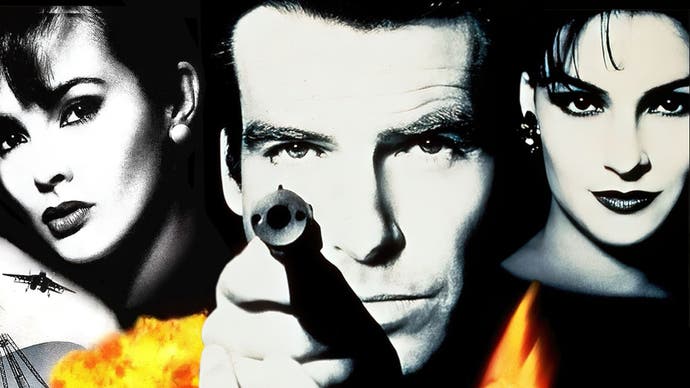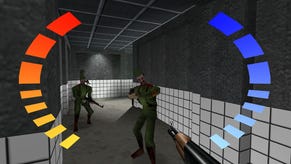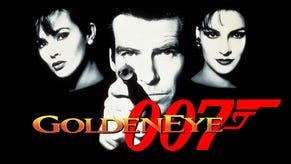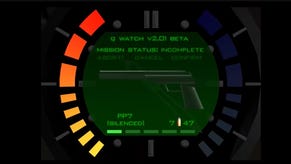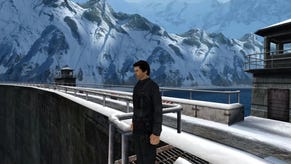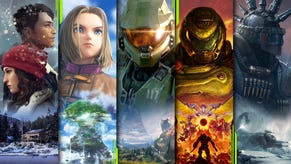Goldeneye 007 is out for Series X/S and Switch - but how do the ports compare to the N64 version?
The full DF Retro EX treatment.
Since its original release on Nintendo 64, GoldenEye 007 has become an almost mythical game, the subject of countless stories about its four-player split-screen deathmatches or objective-driven single-player missions. That mythos has led to remasters and re-releases over the years, but the recent releases for Xbox consoles and Nintendo Switch still came as a shock.
While their arrival is certainly a cause for celebration, it didn't take long before the complaints started rolling in too - over the quality of the emulation, the controls and even the music. Given the response, I had to find out just what exactly is going on with these re-releases and that's what we're here to do today.
Despite its impact, GoldenEye's never had a perfect remaster. The closest we got was an Xbox 360 title that featured a ton of promise - updated visuals with a toggle for the original look, 60fps gameplay, perfect image quality and smooth controls - but it all fell apart at the last minute and was only leaked in playable form in 2021. The game changed the face of FPS and defined the N64, but for a long time it seemed like rights issues would prevent any remaster from coming to market, despite the efforts of countless developers pitching reboot plans.
But in 2023, against all odds, we got not one remaster but two - for Nintendo Switch and Xbox consoles, including Series X/S. Both are based on emulation; on Switch using iQue's emulator designed for Switch Online while on Xbox using an updated emulation layer based on the work done for Rare Replay. Each release uses its own modified ROM; on the Xbox side all traces of anything Nintendo were removed and hacks were added to improve the controls, while on Switch the focus was removing unusued textures of Roger Moore, Sean Connery and Timothy Dalton - presumably to ensure a watertight legal defence against any rights issues.
On the surface, what's here is perfectly serviceable - it's GoldenEye running on new consoles. It promises some improvements, such as smoother performance, but don't go in expecting a proper remake or remaster. However, both versions exhibit issues - most notably around how the vintage 3D graphics are presented.
The Xbox version aims for 4K rendering while Switch operates at 720p - both are significantly higher-res than the original 240p visuals, which is an issue when the artwork in these games was designed to be seen at 240p on a CRT. By increasing the resolution, the flaws are laid bare for all to see.
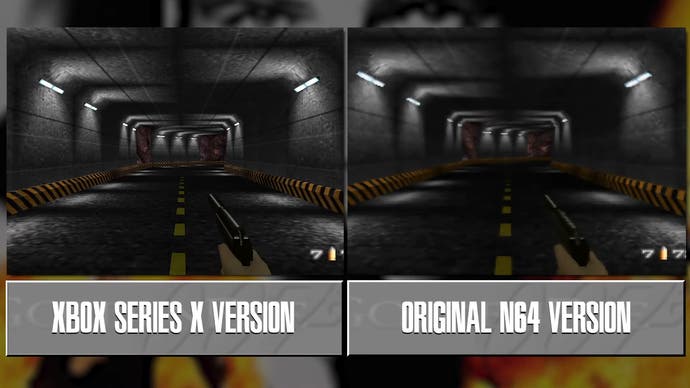

Furthermore, in the case of the Xbox version, the emulation highlights other issues - warbling vertices, visible texture seams and lots of z-fighting. Now, you might be expecting me to criticize the emulation here, but in reality, this is actually more accurate than what is used on Switch. It's a symptom you'll notice with low-level N64 emulation - so that means Xbox version developer Code Mystics' emulation work is pretty robust.
However, this Goldeneye port occupies a strange middle ground where aspects of the rendering are accurate while others are not. For example, the unique tri-point texture filtering inherent to N64 is absent. Furthermore, while the 3D is rendered in high resolution, the math driving it seems to be limited by the original low resolution output of the game which, which may explain why the gently warbling vertices and textures stand out so much. They are present on real hardware, but it's difficult to discern at 320x240.
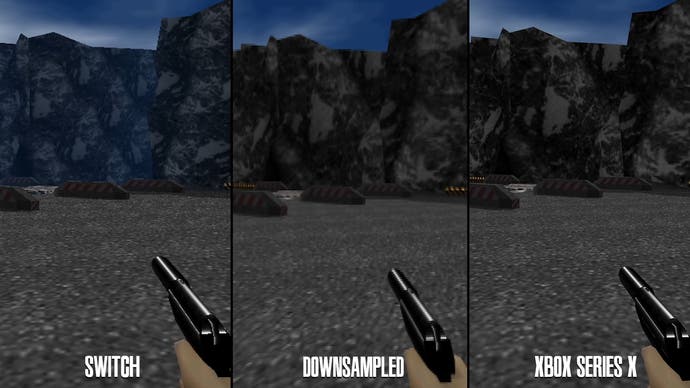
This could have been fixed by downsampling, where the game is rendered at 4K or another high resolution with improved colour depth and other enhancements, then shrunk back down to the original target resolution, using all that extra data to produce a more detailed look than the original visuals - but one that feels true to the original art direction. This approach works well for GoldenEye using PC emulation, so it's a bit of a shame that we didn't see a similar approach here as the game looks uglier than it should.
There are also some oddities to do with the frame-rate. Code Mystics specifically mentioned that 60fps was off the table to prevent inaccurate game behavior, but their version features issues with enemies clipping through walls and other weird behaviour. Similarly, while on a real N64 the game plays Nintendo and Rare logos at 60fps, on the Xbox version they're 30fps - although the Switch port does get this right. So overall it's a weird mixed bag of accuracy combined with obvious inaccuracy that ultimately hurts the experience.
Of course, these are relatively minor issues compared to the actual frame-rate, which was typically very poor on the original hardware - with some missions running around 10fps for long stretches, and split-screen multiplayer not faring any better. Despite this, the game still feels decent to play as a result of careful camera movement, subtle momentum and fluid animation - ensuring it at least remains moderately playable even when scraping single digit frame-rates. With this in mind, then, the new releases run significantly smoother than the original.

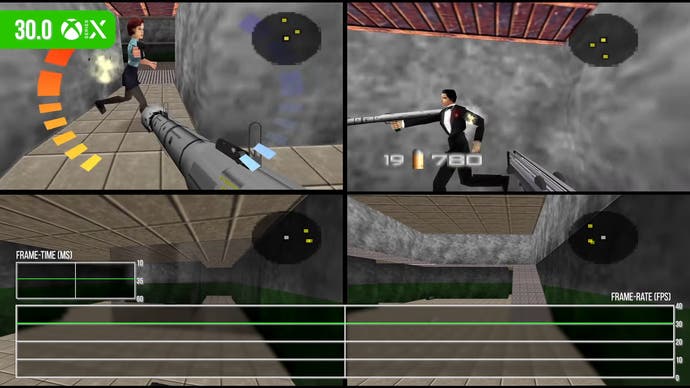
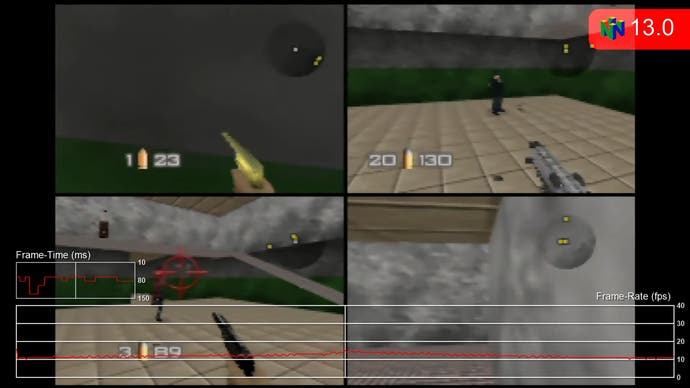
On Xbox, there have been many complaints about performance with its 30fps cap and users reporting stuttering and slowdown. I experienced this too, but measuring the frame-rate results in a near locked 30fps - it looks like the frame-rate cap is working in a sense, but perhaps the distance your character travels between frames is more variable than it should be. This makes the game feel more inconsistent than it should, even though it's light years beyond the original game.
Switch, despite initial impressions, runs more slowly than Xbox with frequent frame-rate dips and unstable frame-times. Again, it's faster than the N64 original, but not as stable as it should be. This is particularly galling when the unreleased Xbox 360 versions offers a completely locked 60fps in all modes.
As well as the litany of visual and performance complaints, there are some other problems in these remasters. Most notably, the Xbox version features exceedingly muffled sound; it's compressed and crunchy in a way that the original on N64 is not. Considering the quality of the game's music, this is a real disappointment. The Switch version fares better, with nearly identical sound and music compared to the original release.
But while Switch does well on the audio side, its controls are a bit of a mess. The default controller mapping here suits the unique N64 controller, but on the Joy-Cons or the Pro Controller there are some definite oddities - like firing with ZL and strafing left/right with the right stick. To fix this, I'd suggest choosing the '1.2 solitaire' control scheme in-game, then swapping the analog sticks and remapping the ZL button to ZR in the Switch system menu. You can make additional adjustments if you wish but fundamentally, making these changes allows the game to control much like a modern dual stick first-person shooter.
The Xbox controls are significantly easier, as they've been tuned to behave like a modern FPS with dual analogue support, typical button mappings and even modification of the aim setting. These changes do impact techniques used by seasoned GoldenEye vets, like strafe running, but I think for most players this is a logical setup.
Ultimately, when we're talking controls, visuals and sound, neither of these new releases are anywhere near perfect and are overall disappointing. Each has its own advantages - controls are better on Xbox and it runs faster, while Switch has online multiplayer via the NSO service and better audio.
The thing is, neither release really does justice to this game and its legacy. There's no context here - it just feels like a random ROM dump. I could envision something so much more robust but it'll never happen. With all the licensing nonsense surrounding this game, it's a miracle it made the jump at all.
Still, it's hard to complain about an additional way to play GoldenEye and it doesn't take away existing options. You can still use a real N64 or fire up an N64 emulator to enjoy the game at 60fps - there are even mods to add new fonts and UI elements to the game at a much higher resolution. There are other options too, but the point is that GoldenEye has never been more accessible.
And despite its dated visuals and subpar performance, my respect for GoldenEye has only increased over the years. It brings together so many disparate elements into a cohesive and enjoyable whole. The missions are all relatively short but are designed almost like miniature sandboxes, with a wide range of objectives and tricks to uncover. The clunky gadgets and obtuse objectives would feel out of place in a cinematic scripted game and would be impossible to enjoy in an open-world title, but in GoldenEye, the constraints create something that feels just compact enough to be enjoyable. As you learn the maps, your execution improves, almost channeling arcade-like sensibilities.
The multiplayer too, while very simple, remains fun and customisable. My son had never played this game before being enlisted to help out with our testing, and despite describing the game as having 'the oldest graphics he's ever seen', by the end, he was laughing and jumping around the room having a blast. The core of GoldenEye remains as golden as its name implies.
